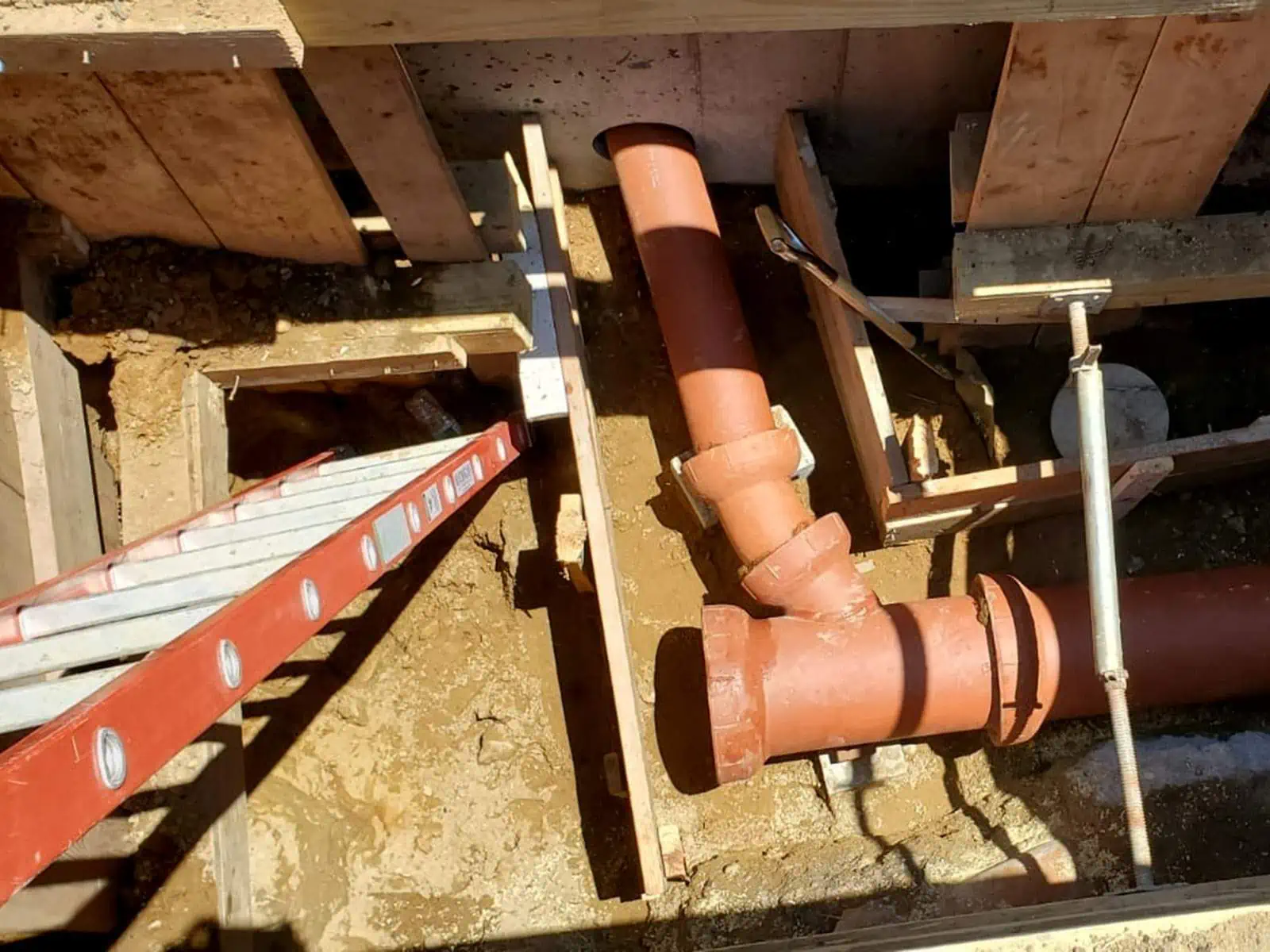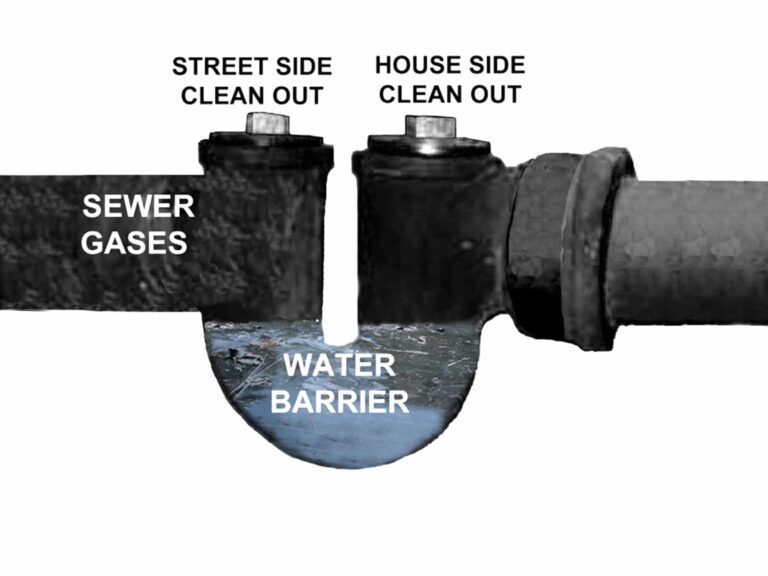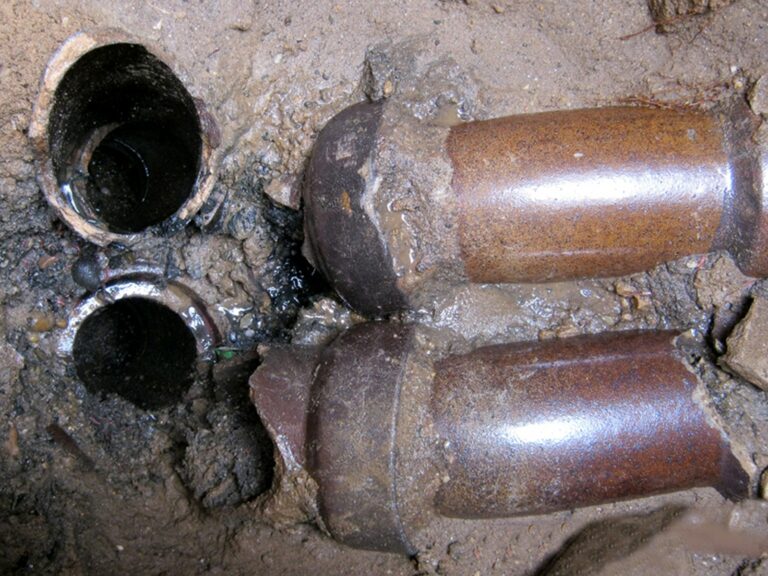A sewer drain, also known as a house sewer, is a mandatory part of any home’s drain system. The drain system itself is designed to carry wastewater away from the point of the building itself to the public sewer system, or a septic system. Before your wastewater gets to the main house sewer, it typically collects in the house drain from other branch lines such as sinks, toilets, showers, and other drains.
The connecting point between the house drain and the house sewer is typically your main house sewer trap. In terms of technical plumbing definitions, the house drain and sewer pipe are two systems.
What follows is what we hope to be a complete guide defining the different types of sewer drain components, and answer the 10 most common questions from property owners. We will also answer some common pipe repair questions as well.
An Explanation of the 7 basic different types of sewer drains
Let’s define the 7 different types of sewer drains based on their functions, and their typical location:
- House Building Drain: While technically a house sewer and a house drain are considered different, most property owners would consider them both part of the same system. In New York City the definition of a house drain ends at the exterior side of the foundation wall of any building.
- Main Sewer Line: The main house sewer, or building sewer, is the pipeline that connects a building’s plumbing system to the municipal sewer system or septic tank. As per the recently updated NYC Department of Buildings definition, the main sewer line starts at the point outside of the foundation wall of a building.
- Branch Sewer Lines: Secondary pipelines that connect individual fixtures (like toilets or sinks) to the main sewer line. While branch drain lines are perfectly legal inside a building in NYC, branch sewer lines connecting plumbing fixtures are expressly not legal after the main house trap in NYC. The one exception would be in a combined house sewer, where the stormwater piping is wyed into the house sewer after the main sanitary house trap.
- Floor Drains: Area drains that are located under the floor, often found in basements, garages, or utility rooms, are designed to remove excess water. In some cases, they are meant to prevent flooding in case a water heater or a boiler should crack or rupture. These are technically considered part of a house drain system.
- Storm Drains: Storm drains, and their branch lines, collect rainwater and prevent building or yard flooding. Storm drains typically either divert rainwater away from properties, connect to a public sewer, or connect to a dry well.
- Catch Basins: A catch basin can be either on private property, or part of a municipal sewer system. A catch basin is sort of a large underground concrete container, that has a drain grate on top of it. In most cases, it is connected to either a dedicated storm sewer or to a dry well of some sort. A catch basin is located in the public roadway, or paved parking lot areas.
- Sewer Clean-outs: A sewer clean-out, even though not by definition, can mistakenly be considered a sewer drain by many folks. Sewer clean-outs can be located on the public sewer, which are manholes with fitted covers. But, clean-outs are located throughout a typical building’s drain system. In all cases, a clean-out on a drain line is meant to provide access for cleaning, and checking on the status of the drain system itself.
Top 10 questions homeowners often have about sewer drains:
- What causes sewer line blockages? Contrary to popular belief, a properly installed drain that is not abused does not typically clog or backup. With that having been said, fat, oil, grease, roots, and flushable wipes are the main causes of a sewer line backup. Interior drain clogs are also frequently caused by hair, due to the smaller size of the drain lines inside the home.
- How can I tell if my sewer line is clogged? There are 3 most common signs of a clog. Of course, number one is wastewater bubbling out of a drain or house trap. But before that happens, the other two signs of a clog are gurgling sounds, and water draining slowly.
- What should I do if I suspect a sewer line problem? If you have a main house sewer problem, in almost all cases it is best left to a professional and licensed sewer contractor. Something as seemingly simple as not knowing how to correctly and safely open the main house trap can lead to a disaster.
- How often should sewer lines be inspected or cleaned? A simple answer is that, unless you have periodic drain or sewer backups, never. If it isn’t broken, don’t fix it. On the other hand, if you have periodic sewer clogs, at specific time intervals, try to schedule cleanings a bit before the usual backup typically occurs.
- What are the signs of a sewer line leak or breakage? Sewer line leaks are hard to know about on a buried sewer pipe. However, in some buildings, the sewer drain is above the finished floor. In those cases a sewer leak will be visible, in other cases a sewer dye test can be performed. In the case of a potential sewer break, the best way to definitively diagnose it would be by having a sewer camera inspection performed.
6. Can tree roots damage sewer lines? The quick answer is 100% yes. As tree roots continue to grow inside of pipes, they also get thicker and wider. Eventually, the tree roots will split, and break apart the sewer drain pipes. There are various tools to cut out roots inside of pipes, and there chemical chemical treatments for when roots are inside of drain pipes as well.
7. How can I prevent sewer line issues? Preventing sewer line issues is frequently a matter of simply respecting your building’s drain systems. Do not let the following items or objects enter your drain pipes: fat, oil grease, hair, flushable wipes, and feminine hygiene products.
8. Are there DIY methods to clear a clogged sewer line? There are certainly effective DIY tools and products out there. A set of two drain plungers are a good start. Having some baking soda and vinegar on hand can clear some simple sink drain clogs. Of course, having some simple assortment of wrenches to clear out pop-up sink strainers, or remove drain grates, can come in handy.
9. What factors determine the cost of repairing or replacing a sewer line? There are some basic factors that affect the cost of a sewer line repair or a replacement. To note is that sewer liners are expressly not permitted in NYC, liners are a code violation. With that having been said, the basic factors affecting the cost of a sewer line repair or replacement are the location of the break, the depth of your sewer pipes, and where your property is located.
10. Should I consider sewer line insurance or warranties? Sewer line insurance, more accurately known as a service line protection plan, is a very personal decision. Your decision can even depend upon your lifestyle; if you are home or away most of the time. Secondly, you should read through the plan you are considering carefully. Know the plan intimately before you commit to it. As a point of interest, in NYC roughly 50% of all property owners eligible for a sewer or water line service line protection plan have signed on.
An Expert Answers Questions About Sewer Drain Repair Work
The percentage of sewer or drain clogs that require a repair to the pipe can vary significantly depending on several factors. In New York City, for instance, roughly 10% of all sewer drain clogs outside the house result in a repair or sewer replacement requiring excavation work.
- Nature of the Sewer Clog: The vast majority of drain clogs, like those caused by minor blockages from debris or buildup, may be cleared with simple DIY methods or professional cleaning without necessitating pipe repairs.
- The Severity of the Blockage: If the clog is extensive or caused by more serious issues, like tree root intrusion, pipe damage, or pipe separation, it’s more likely to require repair work.
- Age and Condition of Pipes: Older pipes may be more susceptible to damage, and if the clog is due to pipe deterioration or breakage, repair or replacement might be necessary. As two separate and distinct examples, vitrified clay pipe is immune from corrosion or deterioration. On the other hand cast iron pipe can quickly corrode if exposed to extremely acidic or alkaline waster water.
- Maintenance and Care: Regular maintenance, such as periodic inspections and cleaning, can help prevent severe clogs that lead to pipe damage. It’s best to do this once you hear gurgling sounds, or see slow drains – neither one is a good sign of a properly functioning drain system.
- Professional Assessment: A plumber’s assessment is crucial. They can determine the cause and extent of the clog and provide insights into whether repairs are necessary. This is typically done using a high-definition sewer camera inspection.
Some Final Guidance & Knowledge About Sewer Drain Issues
In the vast majority of cases, sewer lines last for decades if they are properly installed in the first place. As sewers function via gravity, a vital point is that drain lines are installed with proper pitch (the slope on the pipe).
Another point is to address root infiltration before the tree roots destroy the integrity of your sewer drain system. Lastly, if you ever need excavation to perform a sewer repair hire a properly licensed plumber, and have a sewer camera inspection done before making your hiring decision.






